Radiator Valves Explained: A Guide to Types of Radiator Valves

Radiator valves come in many different types, styles, and designs. They are a fundamental part of any radiator or heated towel rail that is connected to a main central heating system using water. Each one is suitable for different types of installations depending on the plumbing system, fitting, and also the intended operation and purpose.
This guide will explore the various types of radiator valves, highlighting their benefits, usage, and how to determine the most appropriate options for different setups.
- What is a Radiator Valve and What Do They Do?
- Where Do I Find My Radiator Valves & Where Are They Fitted?
- Are All Radiator Valves Universal?
- What Are the Radiator Valve Sizes?
- Types of Radiator Valves
- What is A Manual Valve, How Do They Work & How Do You Operate Them?
- What is A Thermostatic Valve (TRV), How Do They Work & How Do You Use Them?
- Smart Radiator Valves
- Angled Radiator Valves
- Straight Radiator Valves
- Corner Radiator Valves
- Dual Fuel Radiator Valves
- Bidirectional Radiator Valves
- Other Radiator Valve Considerations
- Costs of Radiator Valves
What is a Radiator Valve and What Do They Do?
Radiator valves come in pairs and perform a necessary function in controlling the flow of water to heat the chosen radiator or towel rail, as well as other radiators on the same system around the rest of the home. One valve sits on the inlet side, allowing water to flow into the radiator, while the other fits to the other side, allowing water to flow back out again. In a nutshell, regardless of type, one side will open and close to restrict or allow water to flow, with the amount dictating a temperature that works very much like any household tap. As such, if the valve is completely closed, water will not flow into the radiator or towel rail, and it will not heat up, essentially being switched off. If it is fully open, it will let more hot water in to heat the radiator faster, with anywhere in between dictating the level of warmth and speed of heating.
Typically, each of the radiator valves in the pair have different names. One is called a lockshield, with the other side being the control valve, or alternatively known as the tap or wheelhead valve. However, some radiators can be fitted with two control valves, allowing for operation on either side in a completely open system. However, in this scenario, it is recommended one is left fully open and only one side is used to control the temperature.
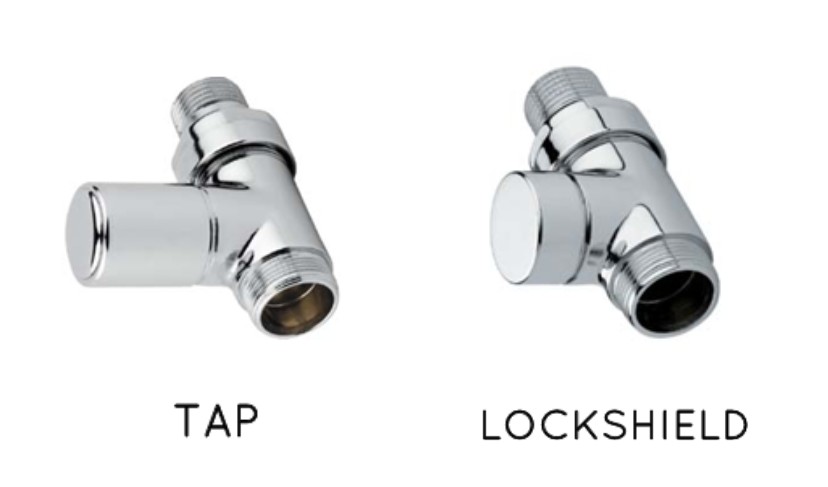
The Lockshield Valve: What is it and What Does it Do?
The lockshield valve is a hard-to-adjust valve that sits on the outlet or return side of the radiator. Its primary purpose is to control the amount of water fed back into the system from the radiator, providing even distribution across all other radiators and ensuring each one gets warm. Whereas the control valve is easy to adjust or move, the head of this valve is usually difficult to adjust without the help of tools such as grips, pliers, or similar. For this reason, it is how it gets its name: it locks in place and shields against unnecessary adjustment once a system has been balanced. Not having a lockshield correctly set can mean only some radiators get warm, while those furthest away get cold. It is also an essential part of maintenance should a radiator need to be drained.
The Control Valve or Wheelhead Valve: What is it and How Does it Work?
On the inlet side of the radiator, there will be a control valve, which can also be called a wheelhead valve or simply a tap valve. These valves come in a variety of styles, ranging from the familiar white twistable tops found on central heating radiators to sleek, modern squared or round designs suited for towel rails. In some traditional settings, you might even encounter valves with wheels that can be turned. They can also operate manually or thermostatically - two specific features that control the amount of hot water entering the radiators - which we will discuss in the next section.
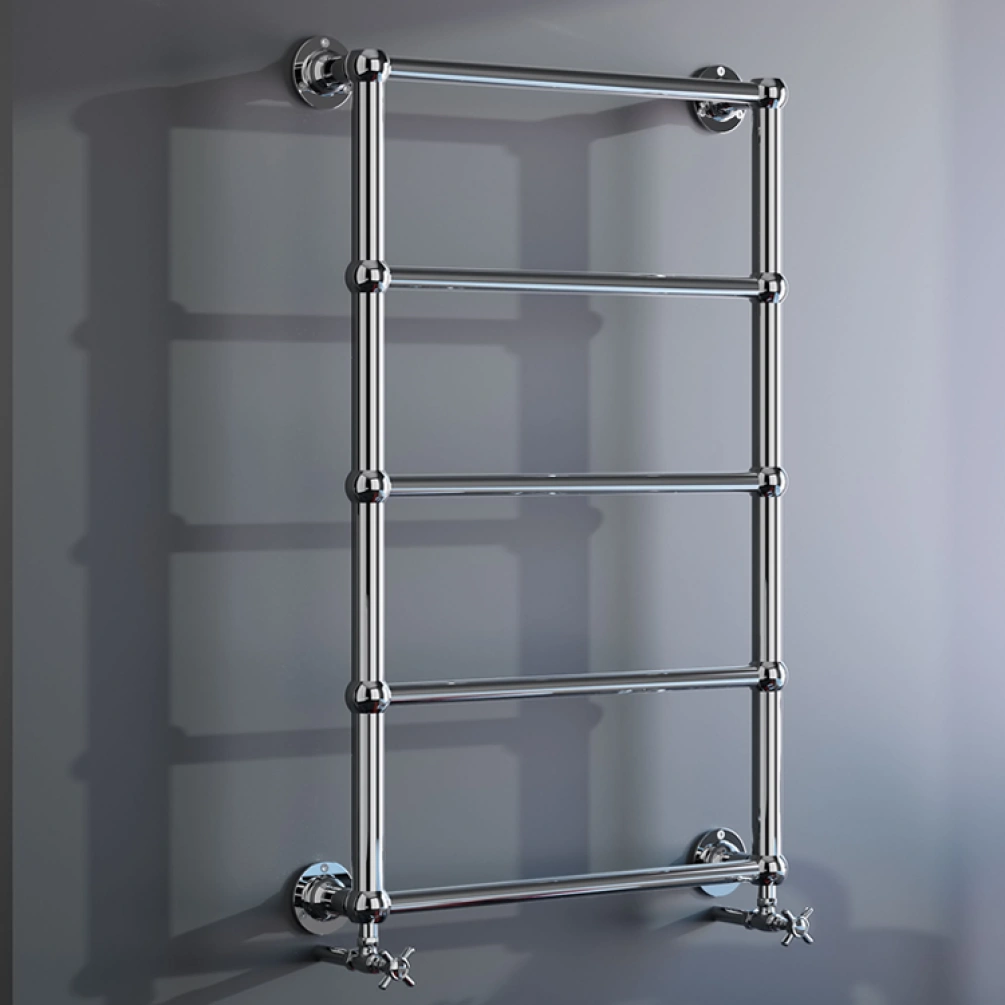
Where Do I Find My Radiator Valves & Where Are They Fitted?
Typically, radiator valves will be located at the bottom end of a towel rail, either connecting to pipework from the wall or floor, depending on how the system has been installed previously. Radiator valves can be installed either directly to the bottom of the radiator or from the side of the pipes, and the placement and pipework will also advise of the type of valves required for new radiators should the plumbing and system remain the same.
Are All Radiator Valves Universal?
The question of whether radiator valves are universal really depends on the context. Regarding the purpose, most radiator valves can be used alongside any radiator for convenience. However, the threads of radiator valves come in different sizes depending on the pipework fitted, as well as many other designs to match and connect to the actual system in place. So, it's not simply a matter of choosing a preferred valve; it must integrate seamlessly with the existing plumbing and setup in your home.
What Are the Radiator Valve Sizes?
The most common size of radiator valves is 15mm with G ½” threads, as this is the size of copper piping that most modern houses have as part of a central heating system. However, not all radiator valves are the same size, with some available with different diameter inlets. This is because some older homes may have much thinner copper pipes that may be as little as 8mm or 10mm, also known as microbore pipes. Additionally, some spaces may have larger pipes of up to 28mm in size for increased water flow to fixtures and fittings. If you’re dealing with differing pipe sizes, then copper adapters will need to be included with the chosen valves or purchased separately. These adapters will help adjust any incompatible pipe sizes to fit a 15mm inlet on your installed valves. Alternatively, you might consider opting for valves designed specifically for microbore pipes.
Types of Radiator Valves
Now that we've covered the fundamental information about radiator valves - including their purpose, functionality, and important factors to consider when purchasing, such as size and fitting - let's delve into the various types available on the market. This section will explain the key differences, how each one works, their pros and cons, and any cost implications to consider.
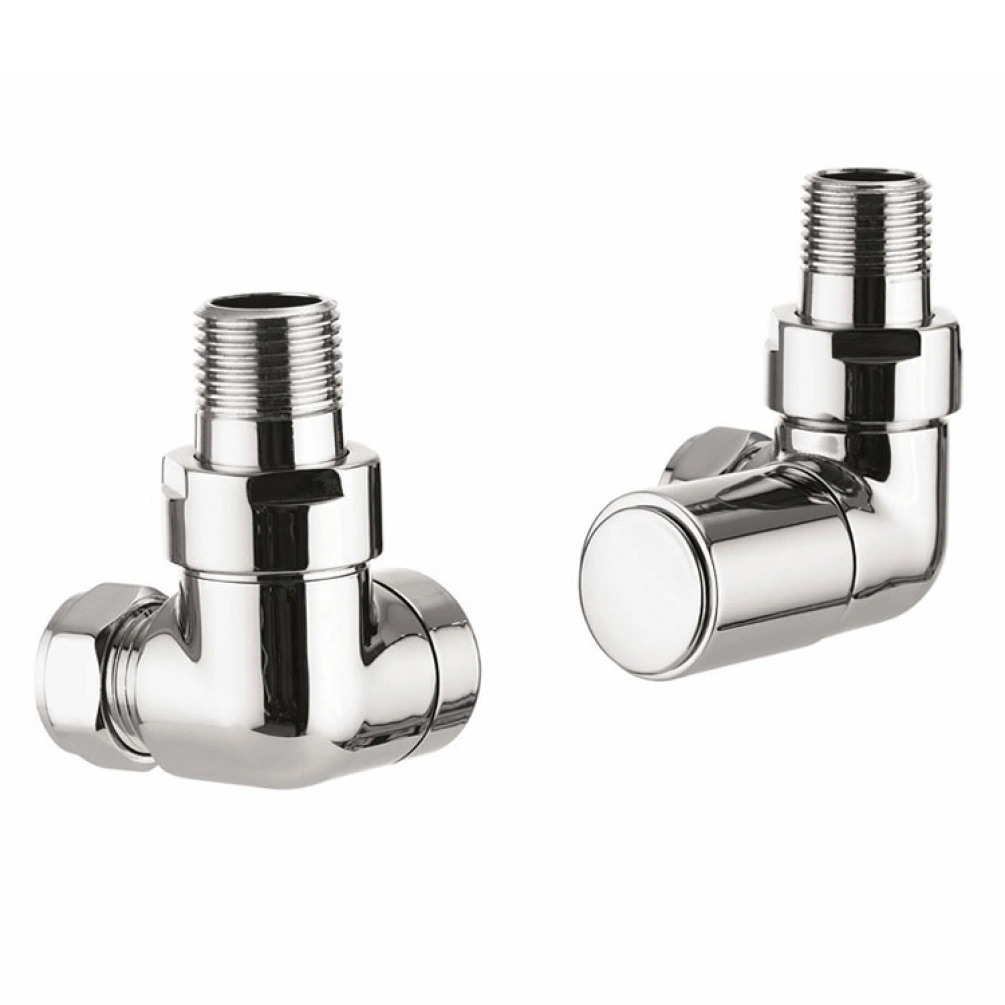
Manual vs Thermostatic Radiator Valves
The first point to contemplate is that of manual vs thermostatic radiator valves. All radiator valves come in one of two types of operation: manual or thermostatic. These will dictate how and when the temperature of any radiator or towel rail is controlled, with each method offering distinct advantages and disadvantages.
What is A Manual Valve, How Do They Work & How Do You Operate Them?
Manual radiator valves are ones that must be operated and closed in person in order to warm a radiator or turn it off. When the control valve head is twisted in one direction, it will open the valve inside, allowing hot water to move around a central heating radiator. The degree to which you adjust the valve determines the speed and amount of heat produced. Conversely, turning the valve in the opposite direction closes it, stopping the flow of hot water and shutting off the radiator's heat.
In many cases, manual valves are used in conjunction with a control thermostat located elsewhere, which activates the central heating system along with any radiators that remain turned on. Once this happens, radiators with manual valves will heat up to the last setting they were left at.
Pros and Cons of Manual Valves
Pros
- Cheaper to purchase & install
- Easy to operate and uncomplicated
- Can adjust each room to be on or off meaning not heating unused rooms
- Common & lots of styles
Cons
- Constant adjustment in person
- Can be costly and expensive in terms of energy costs if forgotten about or left on for long periods
- Can’t set each room to a preferred temperature meaning risk of overheating or not warming enough
Typical Cost of Manual Valves
Approximately, the cost of manual valves typically varies between £20.00 and £150.00, depending on factors such as style, brand and design, as well as the type of installation required.
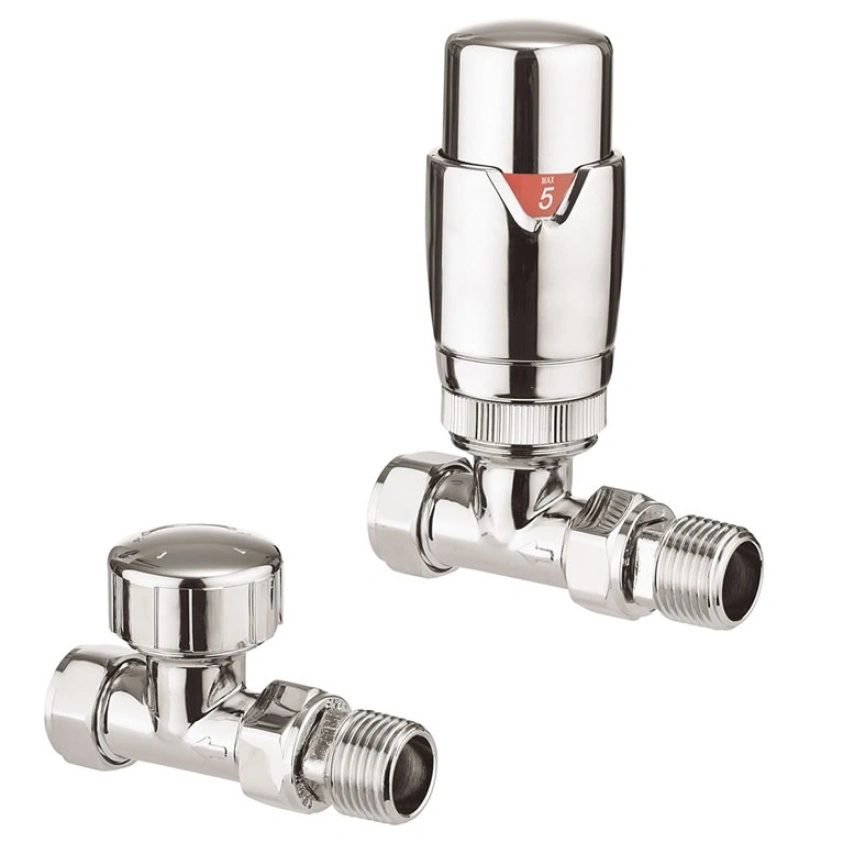
What is A Thermostatic Valve (TRV), How Do They Work & How Do You Use Them?
In principle, thermostatic valves (or TRVs as they are known in short form) still work in the same way, requiring them to be turned to the desired setting. However, whereas manual valves are either on or off and require regular attention, thermostatic valves constantly self-regulate – similiar to other thermostatic items found in a bathroom space.
This self-regulation is typically based on the number selected by the user. The main control valve is marked by a series of numbers,with each number representing a different temperature level, with 1 being the coolest, and 5 or 6 being the highest (depending how high the valve goes). The range of temperatures varies from valve to valve, however, typically at the lowest end this could be anywhere between 5-12 degrees Celsius up to around 30 degrees Celsius for the highest setting, featuring increments in between each number along the scale.
A common misconception is that the numbers on a radiator valve indicate the temperature of the radiator itself. In reality, these numbers reflect the temperature of the room. As a result, many people turn the valve up to the highest setting, thinking it will heat the radiator to that temperature, which, unfortunately, leads to overheating and unnecessary energy wastage when a lower setting would be sufficient for a more comfortable temperature. Once the room temperature is reached, a thermostatic valve will automatically control the flow of water into the radiator, ensuring it doesn’t exceed the threshold. This means you can simply set it and forget it, without needing to constantly adjust settings.
Some radiator designs can be configured with Twin Thermostatic Valves, which operate via a single valve and removes the need for a separate second one.
Pros and Cons of Thermostatic Radiator Valves (TRVs)
Pros
- Constantly adjusts itself to maintain the temperature
- Can help save energy by not more water or energy than is required – estimated by some to be as high as 40%
- Flexibility on temperature in individual rooms
- Added comfort through temperature management
Cons
- More expensive than manual valves to purchase
- TRVs can be prone to misreading temperature & adjusting earlier where rooms are more humid than others
- Can breakdown and fail more than manual valves meaning may need to be serviced or changed more frequently
Typical Cost of Thermostatic Radiator Valves
From a cost point of view, thermostatic valves range from anywhere between £35.00 up to £250.00 depending on brand, colour, style & installation type.
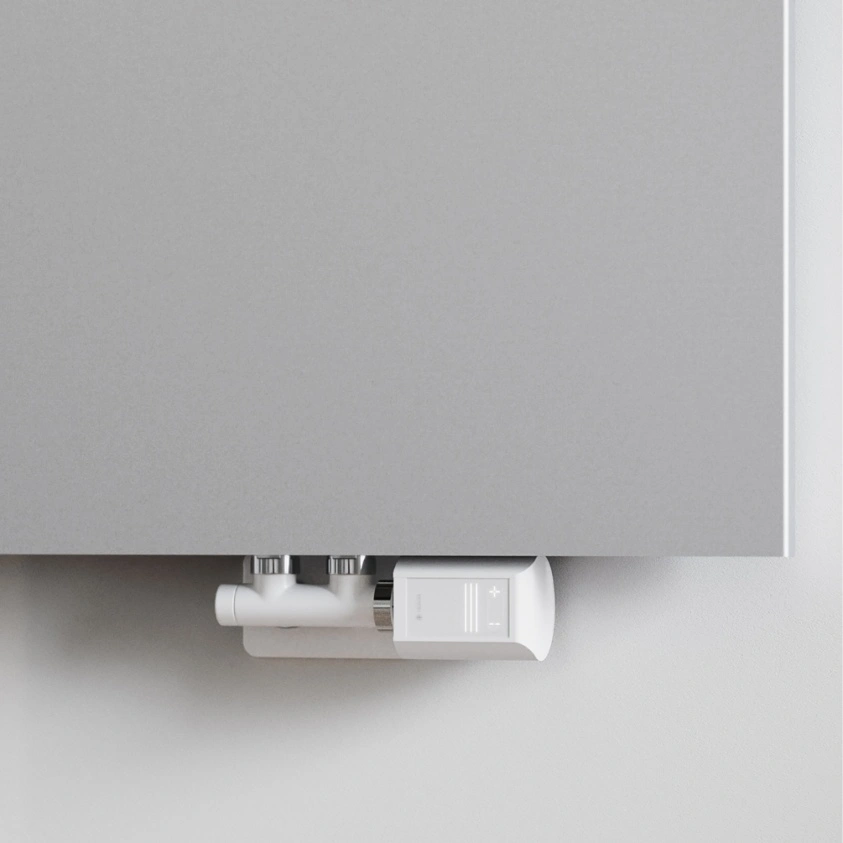
Smart Radiator Valves
Smart radiator valves are ones that can be controlled wirelessly via mobile phone or app. Terma, for example, offer a replacement head for their valves that converts a TRV valve into a smart operated one, giving users the ability to adjust the temperature remotely within a specific range and precise temperature than in increments like standard TRVs. Additionally, the use of an app allows for setting up 7-day schedules around daily routines, ensuring that heating is activated when people are at home and switched off during their absence. This allows for effective management of energy and warmth. Smart valves can also be used in each room, giving users the ability to set personalised temperatures to each space. .
Which Type Valves Do I Need?
After working our way through the main operational control types of valves, it is now time to come to the installation types and the key ones to know about when it comes to finding the right ones for pairing with your system. This will ultimately determine the type you need before picking whether you want manual or thermostatic operation.
There are three main types: angled, straight or corner valves. Each one is designed to work differently depending on whether pipework comes from the wall or floor, and where the chosen radiator has connections. The table below summarises each:
Valve Type | Pipework Location | Radiator Connection Location |
|---|---|---|
| Angled Radiator Valves | Pipework from Wall | Connections at Side or Bottom |
Straight Radiator Valves | Pipework from Floor Only | Connections at Bottom Only |
Corner Radiator Valves | Pipework from Wall Only | Connections at Side |
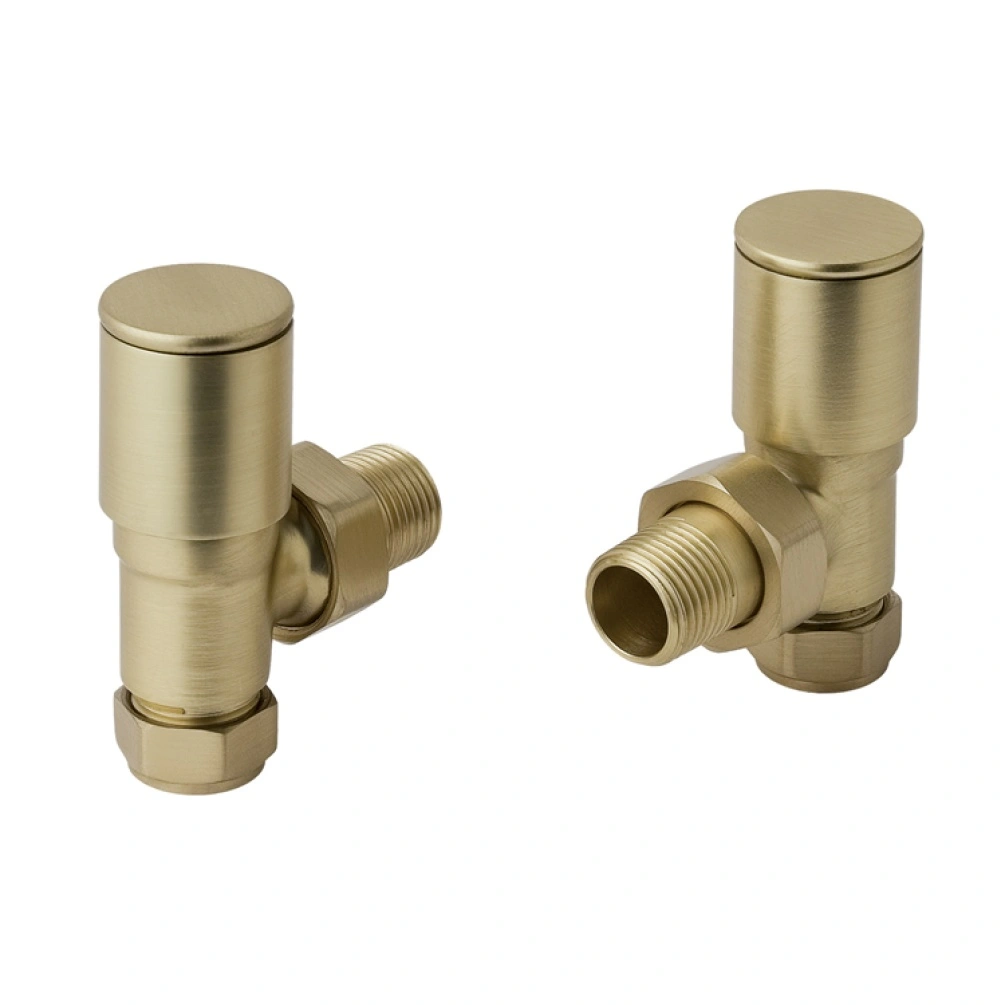
Angled Radiator Valves
Angled radiator valves are seen as the most common and popular simply for the fact they can be installed more flexibly than the others.
They feature an outward connection from the radiator at a 90-degree angle to the valve body, which can be installed vertically or horizontally depending on where the pipework is.

Straight Radiator Valves
Straight radiator valves are designed to fit radiators where pipework is run in a straight line. They feature a straight valve body and an outward head, which is usually turned inwards underneath the bottom of a radiator, hence the name.
In most cases, this will be fitted to pipework that runs straight from floor to radiator with no curves or bends. However, in the rare occurrence where pipework runs around a room, along a wall in a straight line to the radiator, they can be fitted to side connections on the radiator or towel rail with the valve head facing upwards.
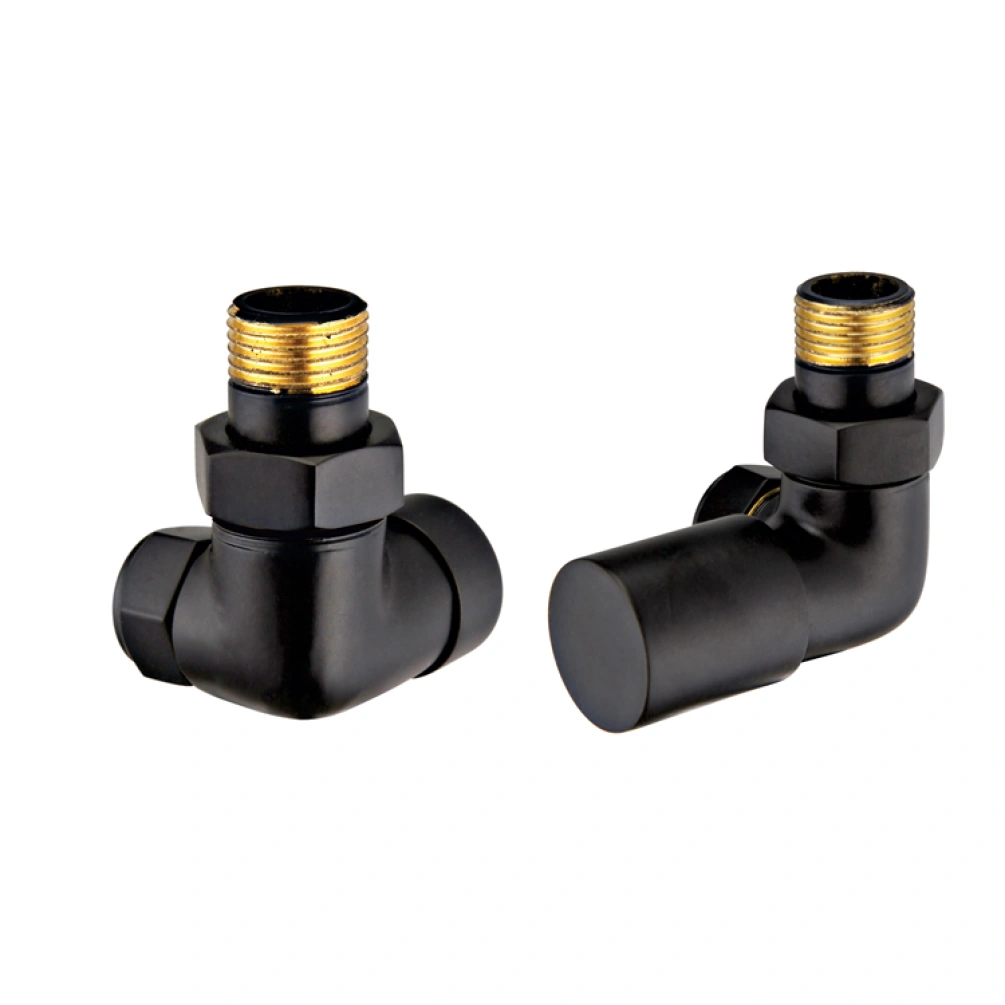
Corner Radiator Valves
Corner radiator valves feature a body that curves in an L-like shape at a 90-degree angle for wall connecting pipework only. This allows for a curve from the radiator to the pipework, depending on where the connection is. For connections at the side, the valve head will be in an upwards position. If the connections are at the bottom, the valve head will sit underneath the radiator inwards.
In reality, the only advantage of using corner valves over angled radiator valves is appearance. Angled valves tend to protrude, which can disrupt the overall look, while corner valves provide a more streamlined finish that keeps everything looking neat and tidy.
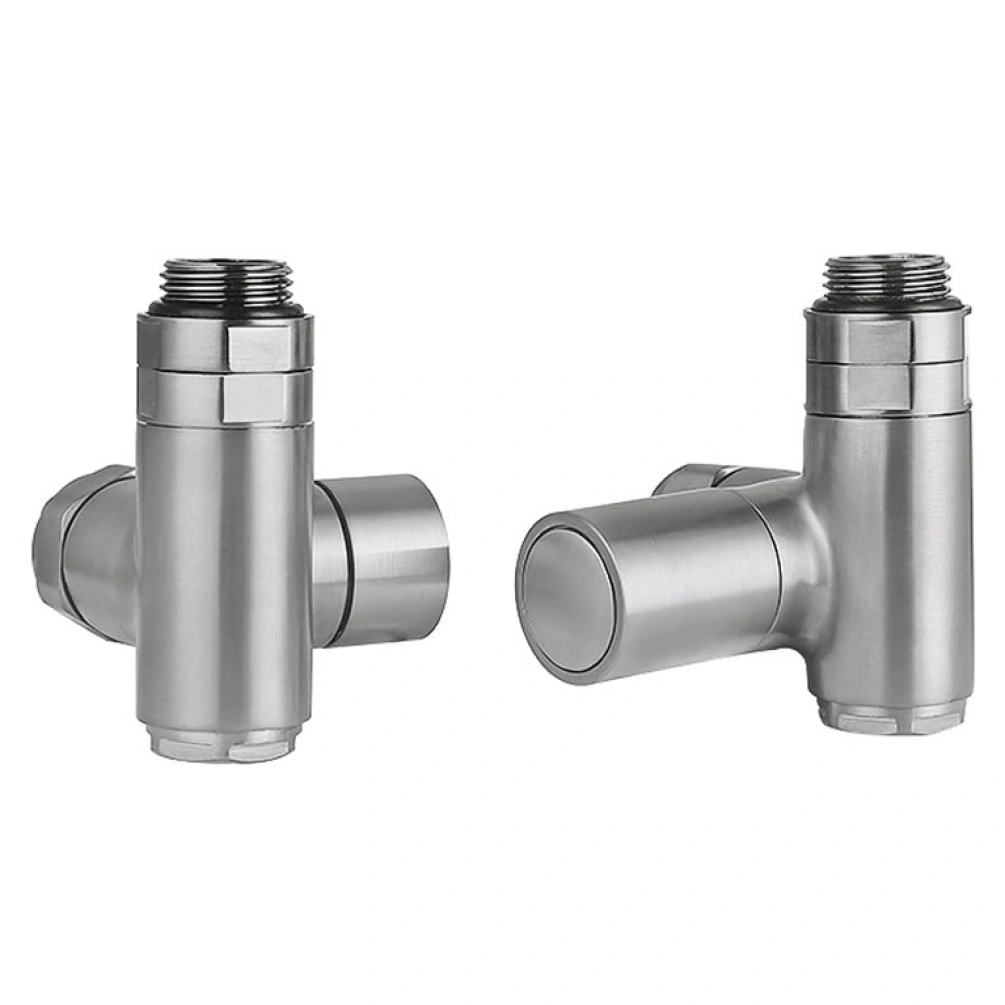
Dual Fuel Radiator Valves
Most people use valves for central heating operation only. However, if all year round use is something that appeals, then converting a radiator or towel rail to dual fuel is an option, as long as the radiator is dual fuel compatible. Dual fuel radiator valves allow for the conversion of a central heating towel rail easily, permitting both a central heating connection and the installation of the necessary electric heating element. These will mostly be in an angled design for convenience, although there are valves available in corner styles as well.
The key difference of using dual fuel valves is that they eliminate the need for a t-piece with an element. If using normal valves, obtaining a t-piece alongside any heating element for it to work will be necessary.
Converting to dual fuel will enable the radiator to operate on electricity during periods when central heating is switched off, leading to energy savings and improved efficiency. This also allows for maintaining a comfortable temperature in spaces as needed during the summer months.
Bidirectional Radiator Valves
Bidirectional radiator valves can work on either the flow or return side of the radiator, meaning this is the main advantage over other valves. This is beneficial for systems where flow is not necessarily consistent. A lot of modern thermostatic valves can operate bidirectionally, however, there are some that are not compatible for this installation. Radiator valves are marked with arrows identifying whether they are unidirectional or bidirectional in order to identify where they should be positioned.
Other Radiator Valve Considerations
Once the type and installation format has been decided, it then comes down to a range of personalisation choices as to which ones match both the space and theme.
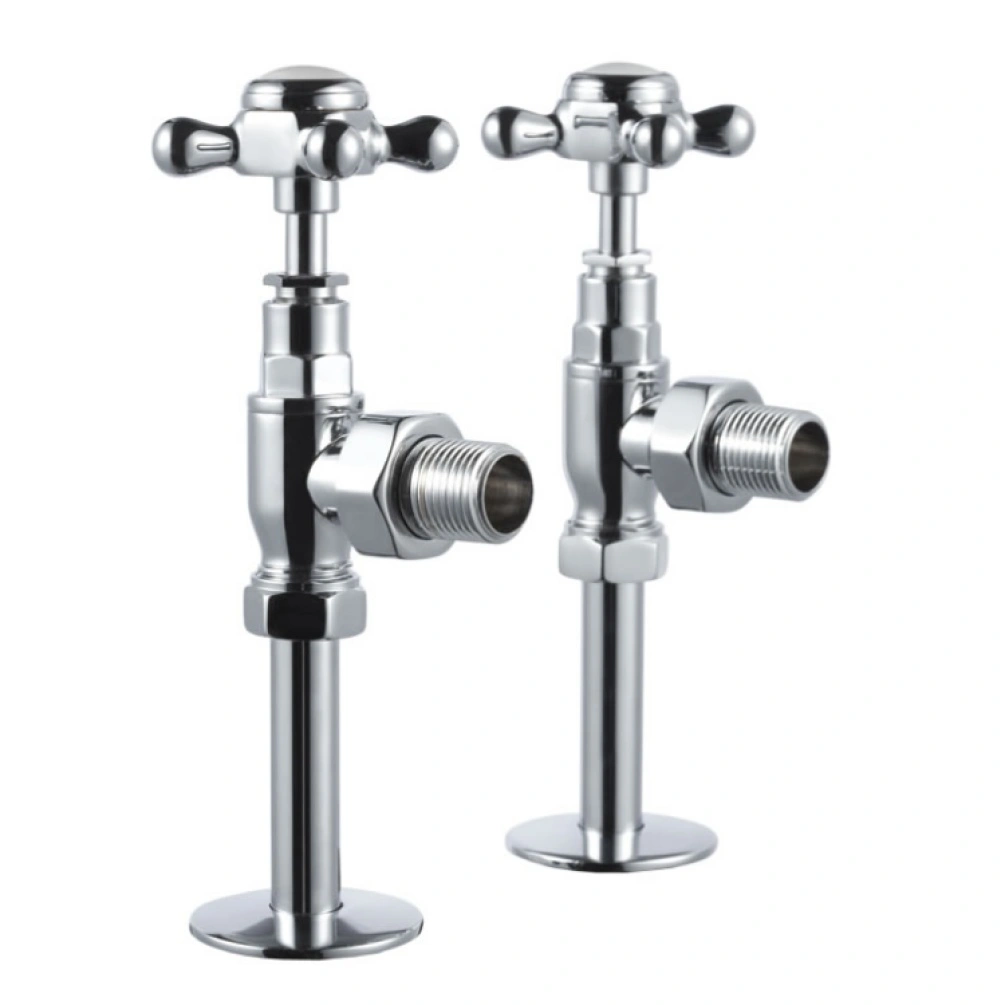
Modern or Traditional
Firstly – like all bathroom products – there are both modern radiator valves and traditional radiator valves available, allowing homeowners to pair the style with both the radiator’s design and theme of the room.
Modern versions tend to feature sleek designs consisting of simple curves or lines, whilst traditional options often come with features like connecting pipe sleeves, flanges, and more old-style controls such as wheel or crosshead handles.
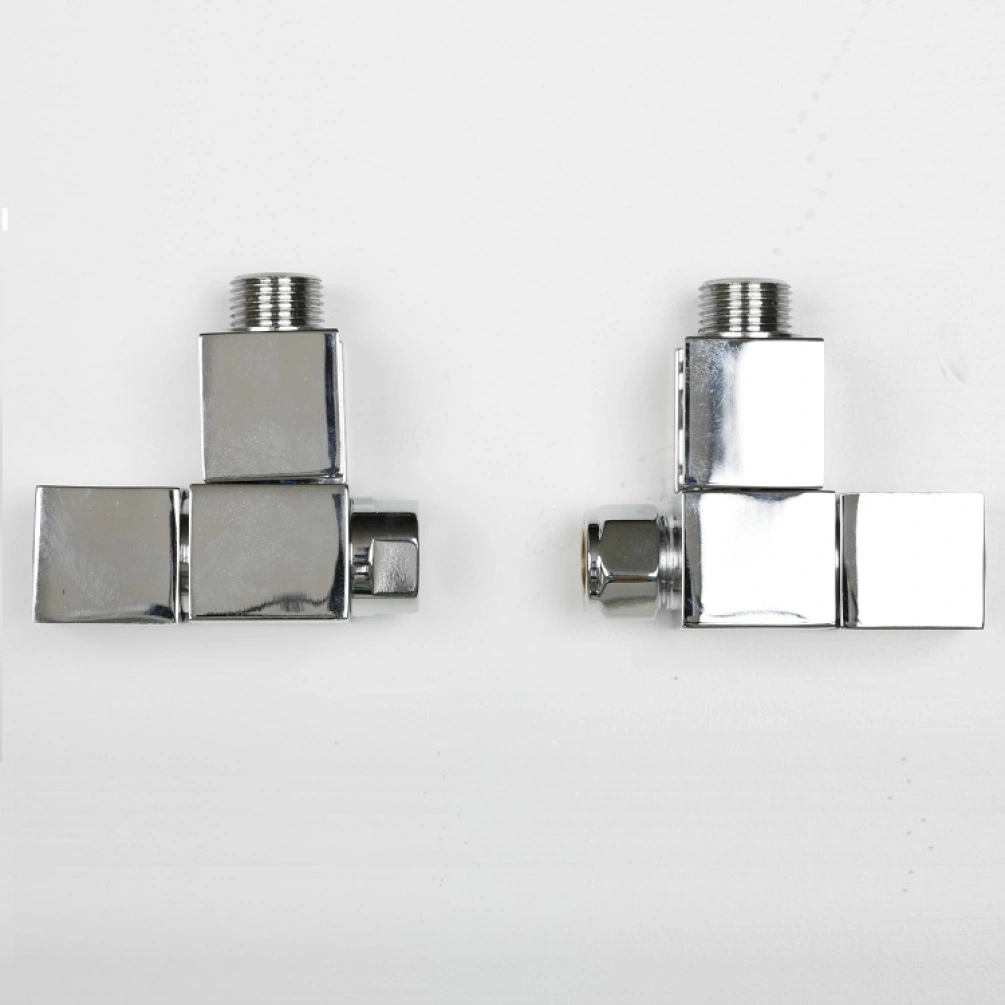
Round or Square
Many modern radiators and towel rails come in a choice of rounded or squared designs. Some brands offer matching radiator valve designs, again providing a consistent and seamless look. If the desired radiator has squared or angular bars, matching valves ensure a superb, finished look.
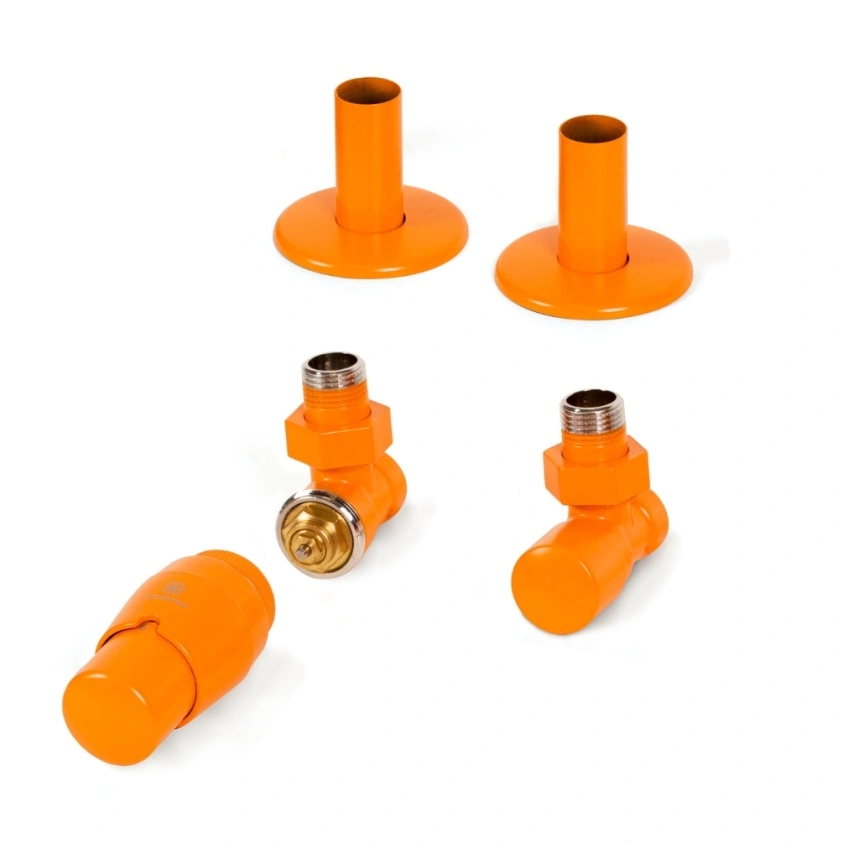
Colour
Lastly, one of the most important factors in choosing radiator valves is the colour preference. Again, many people opt for the same colour as the radiator for consistency. As well as chrome or silver, there is a choice of coloured radiator valves available, including:
- Black
- White
- Grey, Slate and Anthracites
- Nickels
- Warm metals like brass, bronze and copper
- Bright colours like orange, yellow, teal, and many more.
However, bear in mind that coloured finishes can vary from brand to brand – certainly in the warm metallics and coloured finishes. While these discrepancies may be easier to overlook since they’re in less noticeable areas of the bathroom, some individuals prefer consistency in appearance. If this is the case, it may be worth buying the same brand radiator and valves to ensure this is likely to be the case.
Costs of Radiator Valves
While costs have previously been summarised based on valve type, generally speaking, prices start at around £15.00 for more basic models and can go up to £250.00 for high-end options depending on all the factors above. The cost typically depends on how much control you require, the design and colour you choose, as well as the type of installation involved. All these elements contribute to the differences in pricing.
That completes the extensive guide to radiator valves. As shown, there are many different types and styles, and we hope this information helps you choose the right ones for your radiator or towel rail installation. If there is something missing that needs answering still, or if help is still required when it comes to radiators and radiator valves, contact the Sanctuary team for help.
